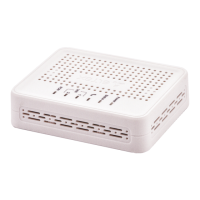____________________________________________________________________________________
____________________________________________________________________________________
NTU Optical Network Terminals 23
3 Device Architecture
3.1 NTU-2V(C) Architecture
Fig. 12— Logical Architecture of a Device with Factory Settings
Main Components of the Device:
– optical receiver/transmitter (SFF module) for conversion of an optical signal into an electric one;
– processor (PON chip) which converts Ethernet and GPON interfaces.
A device with factory (initial) settings have the following logical blocks (see Fig. 12):
br1;
Voice (VoIP block);
eth0…1;
FXS;
IPInterface.
In this case, the br1 block is used to combine LAN ports into a single group.
The eth0..1 blocks physically represent Ethernet ports with RJ-45 connector for connection of PC, STB, or
other network devices. They are logically included into the br1 block.
FXS blocks are ports with RJ-11 connectors for connection of analogue phones. They are logically included
into the Voice block. The Voice block can be controlled through a web interface or remotely with the ACS server
through TR-069 protocol. The block specifies VoIP service parameters (SIP server address, phone numbers, VAS,
etc.)
Filter and Marking blocks are designed to include local interfaces in one group (br1). These blocks are
responsible for traffic rules: Filter is used for incoming traffic, while Marking—for the outgoing one.
The IPInterface block is a logical object with an IP address for LAN access and a DHCP server, which
assigns addresses to clients.

